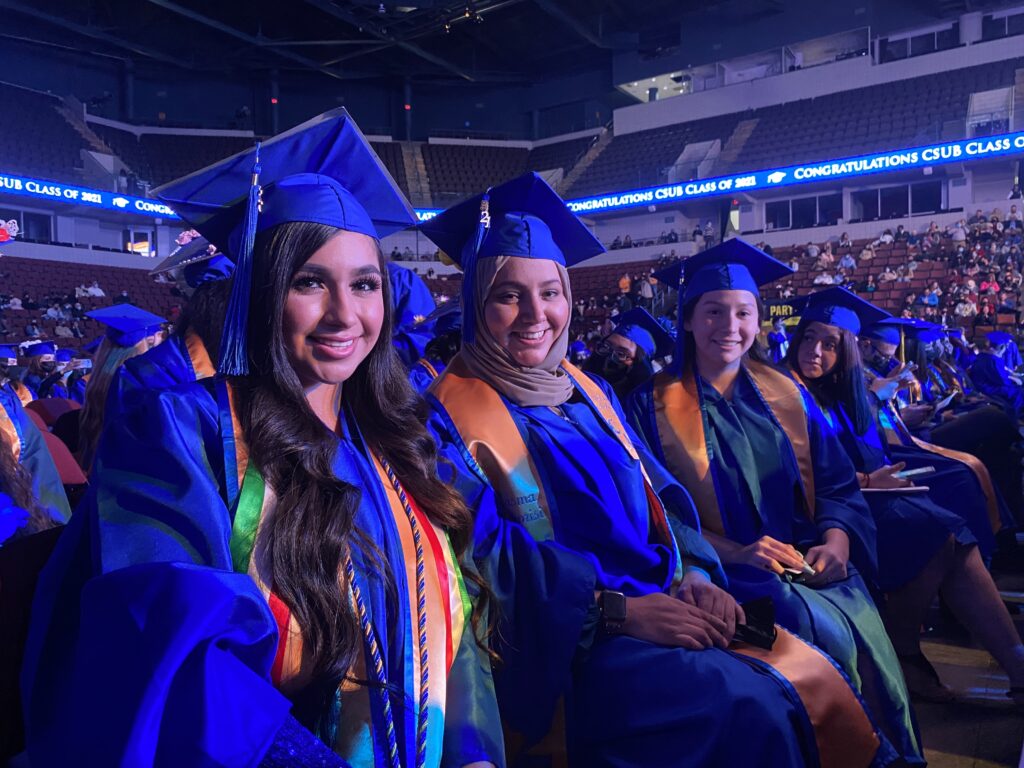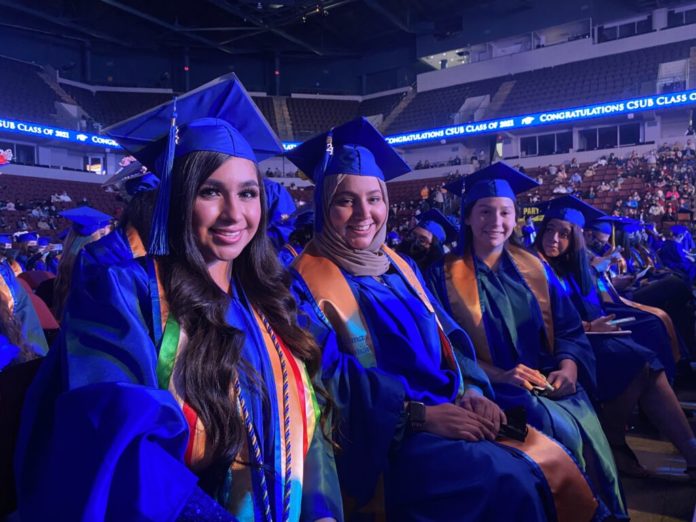 Emma Gallegos/EdSource
Emma Gallegos/EdSource
Students prepare for graduation at California State University Bakersfield in 2021.
 Emma Gallegos/EdSource
Emma Gallegos/EdSource
Students prepare for graduation at California State University Bakersfield in 2021.
A statewide effort to streamline transfer to California’s two public university systems is facing controversy over which classes students should be required to take at their community colleges before making the switch.
The proposed general education pathway — a list of lower-division course requirements — to transfer to the University of California and the California State University so far does not include classes in such areas as psychology, physical education, health science and child development. Community colleges are protesting that omission, claiming it will cause a collapse of enrollment in those courses and harm both faculty and students.
Carole Goldsmith, chancellor of the Central Valley’s State Center Community College District, said the proposed pathway would result in “severe unintended consequences,” causing faculty to lose course loads and making fewer courses transferable, hurting the students it was meant to help.
The situation is so “dire,” she said, that the Community College League of California, which represents the state’s 73 districts, signed a resolution in November asking officials to reconsider the omission of those classes. In December, community college presidents and chancellors in the Central Valley asked for “at the very least” an impact analysis on what the fallout would be.
But advocates, such as the Campaign for College Opportunity, say the alarm bells are being sounded prematurely and without proof that the consequences would be so bad.
The debate springs from AB 928, a state law passed in 2021 that aimed to reduce the confusion and conflicting requirements that community college students face when trying to transfer to UC and CSU. The law called for creating a single pathway of classes to increase transfers and decrease the time it takes for students to finish the first two years of college.
Details and implementation were left in the hands of the Intersegmental Committee of the Academic Senates (ICAS), which includes faculty leaders from California Community Colleges, CSU and UC. The subcommittee has until May 31 to create the pattern, which will then be implemented by the 2025-26 school year, according to the law.
The proposed new pathway does not include current CSU requirements for what is called Area E, or “lifelong learning and self-development.” It is left up to each community college to choose which classes are in that academic grouping, but Area E could include student success strategies, human behavior, sexuality, nutrition, physical and mental health, stress management, information literacy and social relationships, according to the CSU.
Those classes are currently not a UC requirement for transfer.
The majority of transfers go into CSU. Having no Area E requirements would discourage students from enrolling in the courses, avoiding important classes that may help them be successful, community college presidents say.
Claudia Habib, president of Porterville College in Tulare County, said she believes AB 928 is well-intended, “but one solution is not the same for everybody, (and) the impact is not the same for every college.”
If physical education, kinesiology, and student success courses are no longer required to transfer, enrollment in those classes may plummet at some schools, and there would be fewer classes to teach, Habib said.
“We have a lot of personnel that support these areas,” she said.
Part of the problem is that the legislation says that the new consolidated pathway can require no more units than the one UC currently uses, which is 34 semester units. The current CSU pathway has 39 units. So something had to give, officials explained. And since UC did not require Area E, it was cut to create a common set of classes.
Kevin Walthers, president of Hancock College in Santa Maria, said the proposed pathway, as it is, will reduce the number of transferable courses for students.
“When you make things too narrow, it just makes less opportunity for students to get a degree,” he said.
The new pathway makes a student eligible for a transfer but does not guarantee it, depending on grades and competition for space. In an alternative route, an Associate Degree for Transfer, or ADT, guarantees transfer from a community college to a spot somewhere in the CSU. But UC has resisted creating such a system-wide guarantee, despite wanting to increase transfers.
Walthers said college presidents didn’t understand the potential fallout before the transfer-related bill passed, and they’d like to have a voice in the matter.
“It kind of flew under the radar,” he said. “We all want better transfer, right? I wish the CSU system would serve the students in my community — they are woefully inadequate in serving students on the central coast. But when the bill passed, I don’t think anyone really said, ‘Oh this would be an opportunity for the UC and CSU to rewrite transfer in a way that severely impacted community college. No one really got that.”
Walthers and Habib both said community colleges often serve the state’s most vulnerable populations, such as first-generation college students and students of color, who benefit from taking the college success skills courses.
One study shows small impact
The Kern Community College District has done an impact analysis, taking into account which students typically enroll in Area E courses, and found the state proposal would cause minimal impact at its three colleges: Bakersfield, Porterville and Cerro Coso.
“The bottom line was that for KCCD, the elimination of Area E would not precipitate any kind of a major enrollment crisis,” said Craig Hayward, the dean of institutional effectiveness at Bakersfield College. “There are some concerns around being able to round out or keep the workload of faculty coaches, but there are steps to take to get ahead of that and make sure that doesn’t become an issue.”
Hayward said his analysis showed that a majority of students in the district typically take courses in Area E for other reasons than to fulfill the CSU requirement, such as needing it for their associate degree, or enjoying the class.
For example, psychology is an Area E course option that is also a major requirement to earn an AA in psychology. And the student success courses are filled with dual enrollment students from high school. PE courses such as weightlifting are only one unit, while three units are required for transfer. So instead of taking PE courses for transfer help, students are generally taking it “because they want to have that physical activity,” Hayward said.
To ease concern that faculty coaches could lose their full-time job status, Bakersfield College is working to diversify the set of courses that faculty coaches can teach.
Although KCCD may not see major negative changes, Hayward said an impact analysis should still be done on a wider scale because every college classifies the classes in various ways.
How did we get here?
Community college students can currently choose a pathway with different requirements based on which university they want to transfer to. The CSU uses its “CSU GE Breadth,” and UC uses the Intersegmental General Education Transfer Curriculum (IGETC). Although there are some similarities, the two pathways have several differences. For example, the CSU requires oral communication, and UC doesn’t, and UC requires a language other than English, and CSU does not. Both require English, math, arts and humanities, and social and behavioral sciences.
The new pathway, called CalGETC, was proposed in May 2022. It kept English and math requirements and added oral communication, which was not previously required for UC. The arts and humanities and behavioral sciences requirements were also reduced from three courses to two courses each, and ethnic studies now falls in a new separate area.
To earn a bachelor’s degree, students must take classes in their major, as well as general education classes, and many of those can be finished at community college, and transferred over for credit.
Although many students intend to transfer, few do. According to the Public Policy Institute of California, only about 19% of community college students transfer within four years. Black and Latino students are falling behind other groups. Even though they have similar rates of declaring transfer as a goal, “only 9% of Black students and 10% of Latinx students transfer in four years, compared to 17% and 27% of their white and Asian American peers, respectively,” the PPIC said in a 2020 report.
The intersegmental subcommittee made of three members from each faculty senate, plus student and administrative advisers, began meeting in late 2021 and comparing the two pathways to find the best way forward, according to Virginia May, a math professor at Sacramento City College and president of the Academic Senate of California Community Colleges.
“What would be included were subject areas that were common to (both) the patterns, because the units were reduced,” she said.
“Because UC has no such requirement and does not wish to add one, CSU agreed to remove Lifelong Learning from the Cal-GETC,” according to a document from ICAS.
The Academic Senate for California Community Colleges sent out a survey to all the academic senate presidents, curriculum chairs and articulation officers, May said. Many of the 2,169 responses centered around the loss of Area E.
That senate then looked for another way to keep student interest strong in those classes. It passed a resolution urging the CSU to make it a graduation requirement, meaning it could be taken at the community college level, as opposed to an upper-division requirement that has to be taken at the university. Those classes would not be required for transferring, but many students may still take them at community colleges.
The CSU Senate will now discuss those possibilities.
Although May doesn’t see a way forward where Area E is included in CalGETC, “we are nowhere near done,” she said. The panel is trying to work with everyone, “and there are a lot of interests involved,” she added.
Next, the intersegmental panel will convene again to determine if all three faculty segments agree on the proposed path.
“And then,” she said, “we can see where we go from there.”
To get more reports like this one, click here to sign up for EdSource’s no-cost daily email on latest developments in education.





